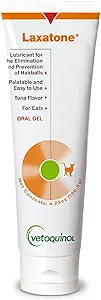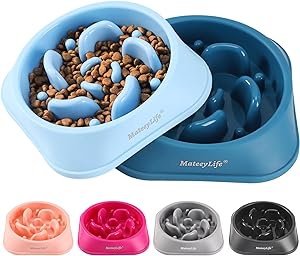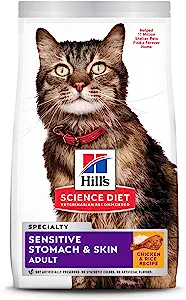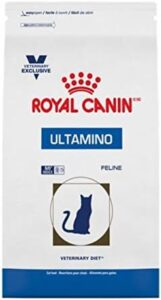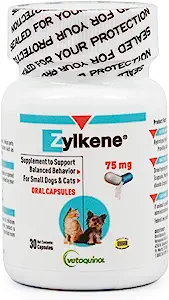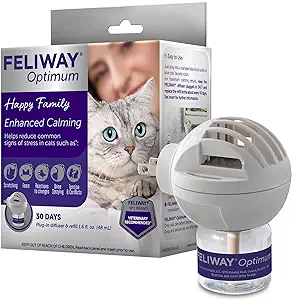Introduction
Your cat has throw up. This is always very annoying, both for your cat and for yourself. Cleaning up vomit is usually nobody’s favourite activity. Cats don’t clean it up ever! He has got you to do that. Every cat throws up occasionally. That’s normal for cats. But when it’s several times a day, there could be more going on. It can be white foam/phlegm, it can be food, but it can also be yellow bile. And sometimes there are also some traces of blood.
More about throwing up, vomiting or puking in the cat
Throwing up can come up very suddenly and make a cat look sick overnight. We call this acute vomiting. In the vast majority of cases, this acute vomiting resolves itself after 2-3 days.
But in addition to acute throwing up, chronic throwing up, or chronic vomiting, also occurs. With chronic throwing up, the cat has been vomiting several times a day for several weeks in a row. In that case, the spitting up is not resolved after a few days.
Is it bad if a cat vomits?
It depends on the age of your cat that is throwing up. In older cats, for example, there may be chronic renal failure where prompt treatment increases its chances to a longer life. But with most cats it is not a problem if your cat vomits once or twice.
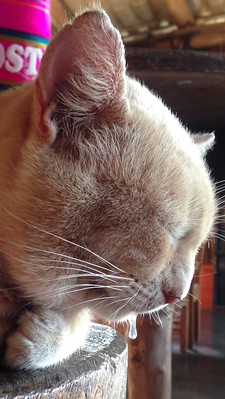
Acute form of throwing up in your cat
Is your cat throwing up from one day to the next? This is usually not a serious problem. Of course, that doesn’t mean that it’s not very annoying that your cat throws up. But in most cases, the gastrointestinal system has just been upset by eating something wrong, by a virus or by a hairball that gets in the way.
Your cat throwing up through toxins
Very often it happens that a cat has been nibbling on a plant in the house or outside. Many plants contain poisonous substances, the so-called toxins. These can irritate the gastric mucosa and intestinal mucosa, which can make a cat feel sick and have him throw up. Sometimes threads of drool come out of the mouth. This will recover on its own after a few days, as long as they stop eating that plant. Please also check the flowers you may have received. Very often this is the cause. (These days there are often lilies in a bouquet. Lillies can be fatal for your cat. So if your cat has been nibbling on a lily, you should contact your vet immediately, even if he / she does not look sick yet)
Cats usually don’t eat other toxins on their own. They are very sensitive to certain flavors. And toxic substances often don’t taste very good. It is rare that a cat eats a certain poison or medication that was not intended for them. If you have seen this, you should immediately contact your own veterinarian to ask what you should do.

Viral infections
Cats, just like us humans, can also sometimes suffer from a virus. This virus can affect the gastric mucosa and possibly the intestinal mucosa. In this case, too, the throwing up usually goes away on its own after about 3-4 days. If your cat really makes a sick impression, it is wise to measure its temperature. With some regularity, a cat has a fever if it has a virus. His normal temperature should be below 39.5 degrees Celsius (102.5°F ). If he has a higher temperature, you can take him to the vet. He will then give him something against the nausea and also prescribe a fever reducer. Then he will feel a lot better. But a cat that is not extremely ill will also recover from his fever itself.
A hairball as the cause of throwing up.
Cats have hooks on their tongues. When they groom themselves, dead hairs stick to those hooks. They are removed from the fur in this way. A cat can then swallow the hairs. Usually this just comes out with the stool. But sometimes they accumulate in the stomach and form a hairball there. When this is the case, a cat will usually throw up on its own to remove that hairball from its stomach. Sometimes they even eat a little extra grass to irritate the stomach and induce vomiting.
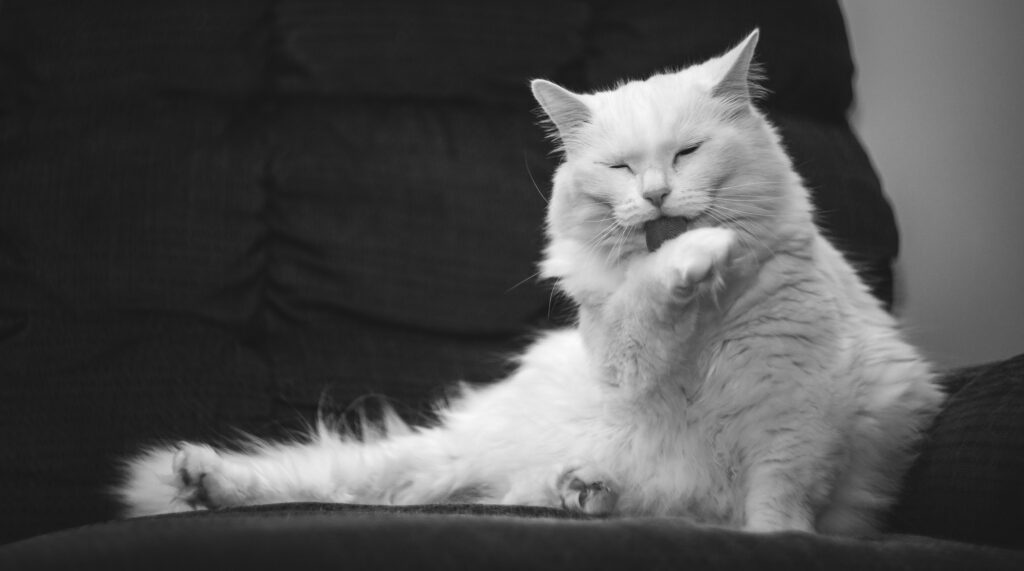
In a few cases, however, the hairball remains in the stomach. Your cat can then vomit about once a day. Other than that, however, he doesn’t seem ill. In between vomiting attempts, he behaves normally. If this fits with the vomiting you see in your cat, you can use Laxatone. By giving about 2.5 cm of this paste to your adult cat for 5 days in a row, the hairball dissolves into smaller pieces that can then come out with the stool. Kittens that throw up must be at least 6 months old for this product and they can be given 1.5mm of paste for 5 days. Does your cat not want to eat it by itself? Don’t worry, just put some of the paste on the front paws. Then he will lick it up because it feels dirty and will groom himself. With that they lick up the paste and swallow it.
Your cat tries to throw up but it doesn't come out
In this case, there is almost always a hairball that is stuck and that he cannot get out. Treat him for a hairball with an anti-hairball paste like Laxatone and he should recover within a few days.
What should you do if your cat is throwing up acutely?
In fact, you don’t have to do much about it yourself. At most give a hairball paste if you think that might be the solution. As mentioned, cats usually resolve the vomiting themselves within 3-4 days. However, it is important that your cat continues to keep enough water inside and that it will not get dehydrated. You can recognize dehydration by a cat becoming very lethargic, the shine in the eyes diminishing and saliva becoming sticky. In addition, a skin fold stays up too long when you pull up his fur a bit. In this video you can see how you can judge for yourself whether your cat is dehydrated. When in doubt, it is important that you visit your vet. He or she can possibly give your cat some extra fluid if necessary.
Furthermore, your cat does not need to receive normal amounts of food. However, it is important that a little goes in every now and then. Only offer him a small amount of food every 2 hours. Preferably something that he likes and is easily digestible. Like boiled chicken breast for example. It is preferable to give this in small amounts several times a day so that his stomach does not get any extra problems. It is important that your cat gets food, otherwise a fatty liver can develop! This is potentially lethal for your cat.
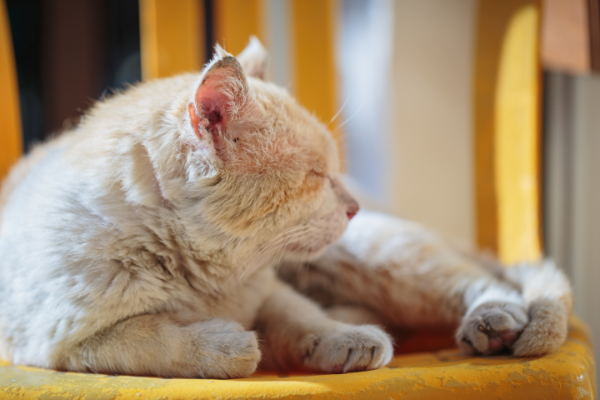
Does your cat make a very sick impression or even has a stomach ache? Then you should not even wait for those 3 days, but immediately go to the vet. So also on weekends. In that case, an object may be stuck in the intestine. As a result, your cat may even die.
How long may a cat vomit or throw up?
As long as he doesn’t make a sick impression, you can look at it for a few days. However, if he is still throwing up after 3 to 4 days or if he feels very ill, it is wise to take him to your vet.
Cat vomits undigested food
When a cat immediately throws up its food after he ate it, we actually call this regurgitation. Very often a cat has hardly any contraction of the abdomen and is certainly not nauseous. In general, your cat eats too greedily, causing the stomach to stretch too quickly. In response, the stomach contracts again and pushes the food out again. The solution is to make your cat eat more slowly. You can do this, for example, by using a special slow feeder. As a result, your cat has to make more effort to eat its food, so it takes in food more slowly.
Is your cat a slow eater by itself? In that case his stomach may not be able to handle his food properly. In that case, try an easily digestible food to see if this changes. If it helps he has a “food intolerance”.
Didn’t this solve the problem? Then there may be something anatomically wrong. The food often does not arrive in the stomach because there is a dilation of the esophagus. Contact your vet if you suspect this.
Chronic throwing up in your cat
But now comes the more serious work. So when there has been vomiting several times a day for a long time, it clearly does not solve itself. In that case, it is wise to look for the cause of your cat’s throwing up with your vet. This can have many different causes. From a hairball that stays put, a stressy cat to kidney failure. Below you will find more information about the various causes.
Hairball as a cause of chronic throwing up
The text below about hairballs is also described at the top of this page for acute vomiting. Cats have hooks on their tongues. When they groom themselves, dead hairs stick to those hooks. They are removed from the fur in this way. A cat can then swallow the hairs. Usually this just comes out with the stool. But sometimes they accumulate in the stomach and form a hairball there. When this is the case, a cat will usually throw up on its own to remove that hairball from its stomach. Sometimes they even eat a little extra grass to irritate the stomach and induce vomiting.
In a few cases, however, the hairball remains in the stomach. Your cat can then vomit about once a day. Other than that, however, he doesn’t seem ill. In between vomiting attempts, he behaves normally. If this fits with the vomiting you see in your cat, you can use Laxatone. By giving about 2.5 cm of this paste to your adult cat for 5 days in a row, the hairball dissolves into smaller pieces that can then come out with the stool. Kittens that throw up must be at least 6 months old for this product and they can be given 1.5mm of paste for 5 days. Does your cat not want to eat it by itself? Don’t worry, just put some of the paste on the front paws. Then he will lick it up because it feels dirty and will groom himself. With that they lick up the paste and swallow it.
Irritated gastric mucosa due to inflammation in the stomach
When a cat vomits a lot, the cause may be that he has an inflamed stomach. This may be due to a food intolerance. But also as a result of a food allergy. Both of these conditions come on early in a cat’s life. If your cat is already 10 years old, this is most likely not your cat’s problem. But if your cat is a year or two, it is definitely worth trying these remedies. In both cases, the solution is to try special food.
In the first place, we start with an easily digestible diet that is suitable for gastrointestinal problems to determine a food intolerance. I personally recommend Hill’s Stomach & Skin. When this bag is used up, the vomiting should be over if there is a food intolerance.
If this is not the case, we will switch to the Royal Canin Ultamino. This food contains no substances to which your cat can react with an allergy. But it is a little pricy. You then have to give this food for 8 weeks. In addition to this food, he should not be given anything else to eat. So no treats, no candy. Typically, his body takes 3-4 weeks to recover from the allergy. So at the earliest you can see result is after 4 weeks and your cat will stop throwing up if a food allergy is the cause. If there is still no difference after 8 weeks, then it will not happen ever. So you have to look for another cause.
Stress as a cause of chronic vomiting
When cats suffer from stress, they can also start vomiting chronically. The exact mechanism by which this is set in motion is not yet known. But they do know that your cat’s nervous system becomes overstimulated. This causes your cat’s nervous system to send signals to his brain. A signal of nausea is then created in his brain, resulting in throwing up. The only solution then is to reduce stress. But that is only easy if you know what the cause of the stress is. And in most cases, unfortunately, you don’t know that. In that case you can use nutritional supplements known to reduce stress or pheromones.
As nutritional supplements that reduce stress, you can use Zylkène, for example. It does have an effect on many cats, but don’t expect your cat to suddenly become super relaxed. It’s not a panacea (unfortunately). Feliway works very well as a pheromone. Unfortunately, this is not a panacea either. If you want, you can also use both means at the same time. In addition to these resources, I often hear people say that they started giving Hemp oil and that that was the solution. Hemp oil has an anti-inflammatory effect (in this case to prevent an irritated stomach) and a stress-reducing effect. Give your cat 1 drop of Hemp oil 2 to 3 times a day. If you do not notice any difference in your cat after a week or two, then it makes no sense to continue with the Hemp oil any longer.
Throwing up due to kidney failure, liver failure, or pancreatitis
When the kidneys or liver of a cat no longer work properly, waste products are no longer properly removed from the body. As a result of these substances, the gastric mucosa can become inflamed, resulting in vomiting. But not only that. The toxins themselves can also stimulate the nausea center in the brain. As a result, a cat may vomit. Kidney failure and liver failure is particularly common in older cats. But younger cats can also get kidney failure, for example, as a result of, among other things, eating lily from a bouquet.
So if your cat has been throwing up for a long time and is a bit older, it is wise to go to your vet and have a blood test carried out. With that blood test, several organs are immediately assessed for their functioning. Don’t forget to ask your vet to rule out pancreatitis. This test is often not part of a general blood test, but must be requested separately. Especially if your cat is very young. A pancreatitis can sometimes give a very sick cat, but sometimes hardly any complaints. So let’s rule it out just to be sure.
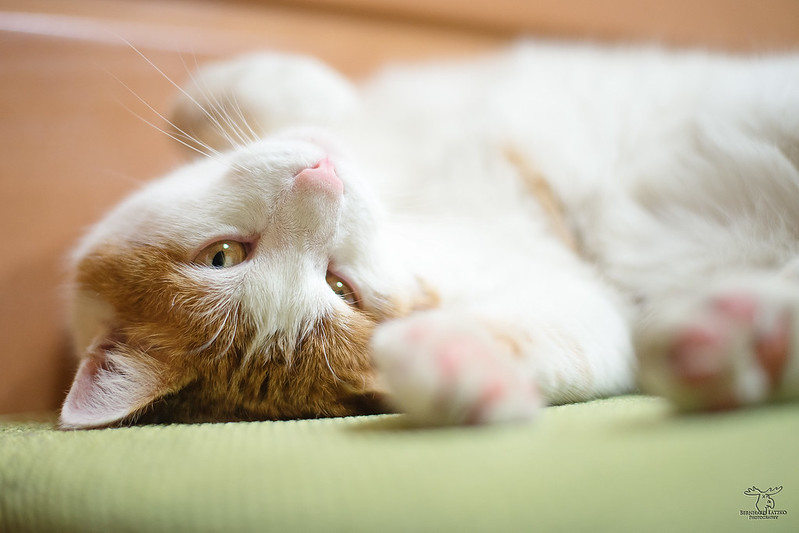
Your cat is throwing up pink slime
In the vast majority of cases, this is caused by a small blood vessel in the gastric mucosa being broken and a small amount of bleeding occured. The red blood mixed with the white foam in the stomach creates a pink color.
However, there also exists pink rat poison. It is therefore important that you check whether the pink is not caused by granules. If you see pink granules in the vomit, it is imperative that you go to your vet as soon as possible. Also in the evening or at the weekend!
Cat vomits foam
The foam is caused because the gastric juice is mixed with air and it has a kind of soap-like structure. This will give you foam. The stomach is completely empty at that moment and there is only gastric juice left in the stomach. This in itself is not something to worry about. It is “just” throwing up.
Cat throws up bile and does not want to eat
When your cat throws up bile, you recognise this as (ocher) yellow vomit. In this case, the digestive juices run from the intestines back to his stomach and are then thrown up. Your cat has been heavily throwing up before and has thrown up his food, his stomach juices and is now starting his intestinal juices. It is therefore logical that he is super nauseous and also does not want to eat. However, the cause does not have to be very serious. But make sure your cat gets enough fluids and doesn’t get dehydrated!
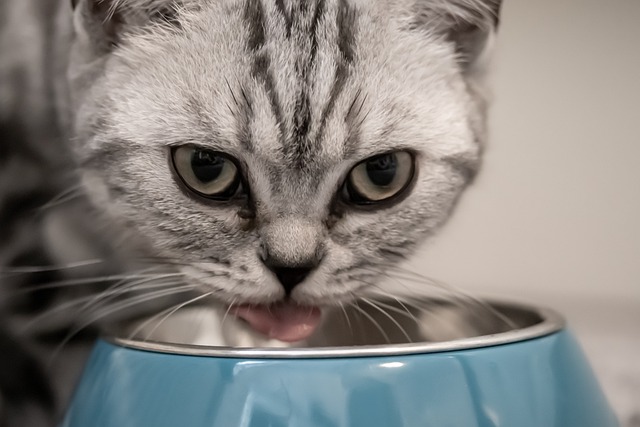
Your cat is throwing up and has diarrhea
Very often a cat starts throwing up but then also gets diarrhea. This means that the cause of the vomiting has now also entered the intestines. Very often this also resolves itself after a day or 3. However, in this case there is an extra risk of dehydration, so keep a close eye on your cat!
Good luck!
Hopefully your cat is not feeling very ill and will recover within a few days. If you worry about him, don’t hesitate to consult your veterinarian! Good luck for both you and your cat!

